Risk mapping throughout the world
 Ice melting © Christine Zenino, CC BY 2.0 Ice melting © Christine Zenino, CC BY 2.0 |
The series of troublesome events affecting the world since 2008 has reshaped the mapping of risks to which companies are exposed. The subprime crisis, the turmoil shaking some Arab countries and mistrust vis-à-vis the sovereign debts have brought to light new threats to economic players. All threats have been the subject of many studies designed for the overall identification of risks and their perception by the market. This work has updated the "chains" of hazards per company and per sectors of activity.
The perception of global risks by the industry’s experts
The evolution over time of the perception of global risks
Risk management enables companies to identify all threats to their business. The debate around this issue has pushed the "World Economic Forum" foundation to conduct a study on the development of the perception of global risks since 2007. The analysis is based on the assessment of hazards by specialists in various sectors of activity worldwide. The findings show that the perception of risks by the economic actors is often highlighted after the occurrence of an event or following a net increase in the threat. This shows that even if the company identifies risks related to its business it has little capacity to anticipate and prevent them. For instance, only as of 2011 has awareness about environment-related hazards appeared in the top five companies’ concerns, that is to say, after the occurrence of natural and nuclear catastrophes in Japan. Another example, economic issues will start to prevail in terms of impact as from 2008/2009 and the emergence of the first global financial crisis.
The overall risk is beyond the capabilities of corporate management and often outruns the State’s capabilities. We summarize below the yearly perception of the five global risks to which companies are most sensitive for the upcoming ten years.
Top 5 global risks in terms of likelihood
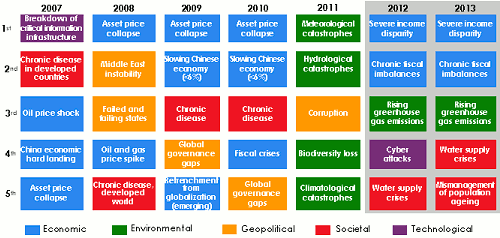 Source: World Economic Forum
Source: World Economic Forum In 2013, the overall risk of most concern to companies for the next ten years pertains to income disparities. This is followed by chronic fiscal deficits and rising greenhouse gas emissions.
Top 5 global risks in terms of impact
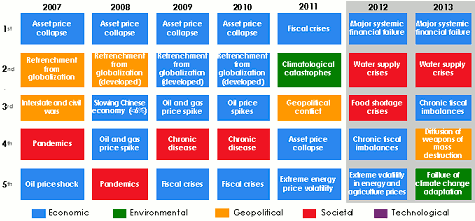 Source: World Economic Forum
Source: World Economic Forum For companies, a major failure of the financial system stands as a risk that is likely to have the greatest impact in the next decade. The economic turmoil following the subprime episode, the bankruptcy of some financial institutions in the United States and the crises within the Eurozone are behind this result. These events have shaken the global financial markets leading to a decline of the economic activity. The insurance market has not been spared by this unfavorable context.
New risks appear in the two tables above, those resulting from the scarcity of drinking water and from chronic fiscal imbalances.
For the World Economic Forum’s analysts, the inability to cope with climate change is one of the most important risks in the next decade. The main challenge lies in managing greenhouse gas emissions whose impact on the insurance market would, then, be considerable. The impact in terms of natural catastrophes, health, and mortality is actually one of the most dreaded subjects. Insurers must, therefore, be able to adapt to the evolution of climate change.
The study also found that economic factors are nowadays the most dreaded risks both in terms of likelihood and impact. Those factors, arising from societal problems or having a geopolitical impact, are losing importance in favor of environmental risks.
Not ranking among the top five, some risks are growing faster than others. They are shown in the tables below, ranking according to a scale of likelihood and impact.
Ranking of risks per likelihood
Risks are classified according to a probability scale ranging from 1 to 5. The rank of each risk depends on the average likelihood obtained in a given year.
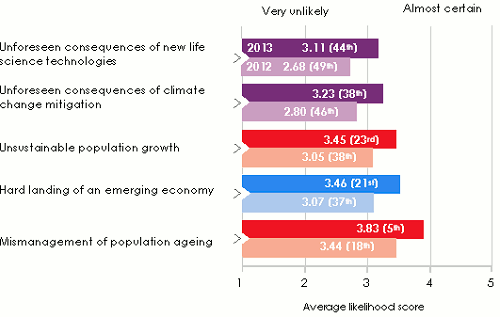 Source: World Economic Forum
Source: World Economic Forum The impact of new technologies on human life
 Fire of batteries aboard a Boeing Fire of batteries aboard a Boeing |
In terms of probability, it is the perception of risks associated with unforeseen consequences of science and technology on human life that has changed the most. The risks from electromagnetic waves, cell phones, nanotechnology, third and fourth generation birth control pills, lithium-ion batteries (mounted on 787 Boeing aircrafts) are a few examples among many others. For insurers, the new type of risks stands as a significant hazard. The limited margin of insurers pushes them to discard these risks from their coverage.
The immobilization of the new 787 Boeing aircrafts due to the use of a new generation of lithium-ion batteries is likely to cause a major claim for the market.
The consequences of climate change
The consequences of climate change are ranking second in this system, with this risk gaining importance in the collective consciousness. Studies conducted by Swiss Re have explained the increasing number of natural catastrophes and their intensity by climate change. They have revealed also that the cost supported by insurers has increased significantly since 1970.
Insured catastrophe losses: 1970-2012
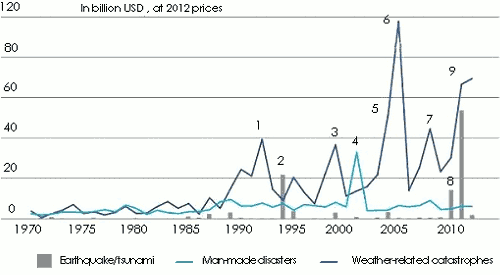
1 1992 Hurricane Andrew | 6 2005: Hurricanes Katrina, Rita, Wilma | |
2 1994: Northridge earthquake | 7 2008: Hurricanes Ike, Gustav | |
3 1999: winter storm Lothar | 8 2010: Chile, New Zealand earthquakes | |
4 2001: 9/11 attacks | 9 2011: Japan, New Zealand earthquakes, Thailand floods | |
5 2004: Hurricanes Ivan, Charley, Frances |
Ranking of risks per impact
The changing perception of the most important risks, in terms of impact, pertain to those related to the States :
- negative consequences of new regulations
- nationalization of resources
- imbalance of the labor market
- downturn in emerging economies
- mismanagement of a population age pyramid.
Risks are classified according to an impact scale ranging from 1 to 5, with the rank of each risk depending on the average likelihood obtained in a given year.
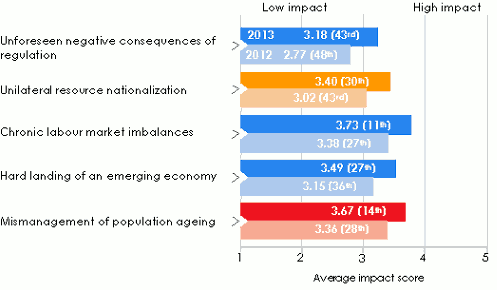
Interaction between the different identified hazards
The "World Economic Forum" survey has placed the identified risks within a chain of threats, allowing to define the interactions among them.
Economic and environmental risks
One of the major challenges of the next decade lies in the simultaneous management pressures on both the economy and on the environment. This challenge is so crucial that many scientists are calling for immediate action to avoid reaching the point of no return characterized by an unstoppable growth of climate-related natural catastrophes. A 4-degree Celsius rise in the temperature by 2060, resulting in increased frequency and intensity of tropical cyclones, coastal flooding, sea levels or drought. The economic crisis coupled with corporate and State resistance to going more "green" cannot be ground for optimism as to a rapid response to deal with these phenomena. Compliance with environmental standards is costly for companies, in terms of production, which constitutes an additional pressure for them as the effects of such actions cannot be felt immediately.
Likely consequences of global warming
The risk of global warming has been studied according to five criteria. An increase in temperature of one degree or more could have catastrophic consequences in the long run. This evolution is shown in the table below.
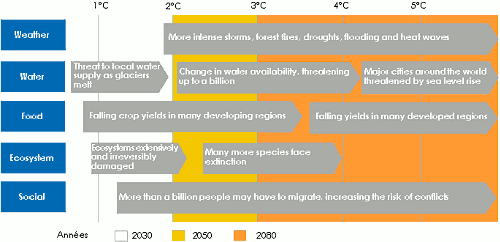 Source: World Economic Forum
Source: World Economic Forum Economic losses related to natural catastrophes
Over the decades, the number of people living and working in urban areas has increased. This trend has increased the cost of natural catastrophes, some of which are related to environmental considerations (floods, cyclones,...):
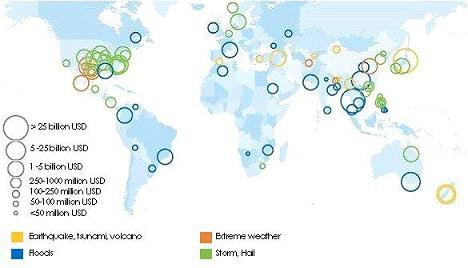 Source:World Economic Forum, Sigma natural catastrophe data base, Swiss Re
Source:World Economic Forum, Sigma natural catastrophe data base, Swiss Re To address these threats, States have a little margin. The huge sovereign debts accumulated by the States significantly restrict their capacity to respond. They struggle to revive the economy and delay projects designed to preserve the environment and whose economic impact is not imminent. Moreover, the annual growth in developed economies between 2012 and 2017 has recently been revised downwards to range, henceforth, between 1.3% and 2.6%.
The impact of hyper connection and all-out digital
Global activity is more and more related to information systems. The impact of a cyber attack, loss of IT data, or an act of sabotage can be disruptive for users and companies storing and using digital data. In such cases the losses affecting companies can be disastrous. These companies’ managers are required to estimate the risks incurred, adopt prevention measures and to determine their insurance needs (see March 2013 issue number 99 of Atlas Magazine).
Threats to health
The threats posed by infectious diseases are relatively well delimited nowadays, with pandemics risks getting scarcer and scarcer as the health measures implemented by the authorities of each country contain their possible spread. Therefore, the devastating effects of epidemics that the world had experienced in previous centuries (cholera, plague, etc) are very unlikely to emerge. However, some dangers, which have appeared in recent years such as bovine spongiform encephalopathy (BSE), also known as "mad cow disease" swine flu or avian flu, claimed many lives in several parts of the world upon the outbreak of the pandemic. These diseases were clear reminders that benign viruses can mutate and threaten health, which was already the case of HIV viruses. The novelty is that even non-risk individuals could be contaminated by casual contact. Such threats should be taken into account by life insurers.
But the most serious risks consist in antibiotic resistance. This threat is related to the unforeseen consequences of science and technology on human life.